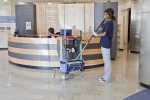Issue Date: 24 November 2016
Ref: DIV16/27
Safer Floors In Winter, Better Floors All Year Round
By Tinaz Ranina, Building Care & Floor Care Product Manager, UK & Ireland, Diversey Care
As winter approaches it is worth remembering that cleaner floors are safer floors. Last year around 7,600 people experienced slips, trips and same-level falls in the workplace resulting in serious injuries such as broken bones. Over 13,000 people had similar accidents that caused them to have at least seven days off work. These injuries are still among the most common in the workplace and the consequences can be severe for all involved: they cause suffering to the injured, disruption for employers and in extreme cases legal action against those held responsible. One of the biggest factors in these accidents is contamination on floors and this is more likely during winter when rain and snow outside increase the risk of dirt and water being brought inside.
It follows that improved cleaning and floor care can play significant role in reducing the risk of slip and trip accidents. In most settings, the area immediately inside the entrance will be at biggest risk because everyone using the building will pass through. All busy areas should be cleaned routinely and regularly during the day to keep them clean. Puddles and spills should ideally be removed as soon as they occur. A mop and bucket kept close at hand might be useful but this method tends to spread contaminants over a wider area and leave a thin film of liquid that actually increases the overall risk. Instead, the latest-generation compact mains or battery-powered scrubber driers will be faster, more effective and leave the floor dry and ready to use again right away.
In practice, good floorcare should be practised all year round. In addition to creating a safer environment there are some other good reasons for keeping floors clean.
Studies in the retail, food service, hospitality and cleaning sectors have shown that customers and employees give favourable feedback and ratings when they like the appearance of the buildings they use. Floors are a big part of this. Regular cleaning will maintain, and can even improve, the appearance of any area by removing dirt and debris that can cause deterioration. Particular attention should be paid to entrance areas, on the basis that first impressions count, and communal spaces because they are likely to be busy.
Another reason to maintain floors properly is protection of important assets. Routine tasks, undertaken at the correct intervals, will protect the floor and delay or eliminate the need for expensive remedial and replacement work. This is true for all types of floor, including carpets. With these, for example, the three-stage regime of daily vacuum cleaning, intermittent cleaning every quarter and six-monthly or annual deep cleaning is advised.
The choice of floorcare products, tools and equipment can bewilder even the most experienced cleaning professional. But introducing innovations can often save time and money. Microfibre cloths and mops are an efficient alternative to mop-and-bucket cleaning that enable new ways of cleaning floors and other surfaces, with better results, improved hygiene and reduced reliance on chemicals to promote simpler and sustainable processes. Advanced floorcare formulations for use with mops, applicators and machines can replace traditional products to reduce the number of coatings and minimise or even eliminate the need for intermittent stripping. Carpet machines are available which combine intermittent, encapsulation and deep cleaning capabilities in a single design for the first time. The latest scrubber driers – including robots - also present new possibilities in terms of speed, efficiency and results. These can be used with brushes and pads for every type of floor.
By choosing and using the best solutions for their particular circumstances, cleaning teams can not only make their floors safer, they can make them look better and last for longer, often by using simpler and safer processes that save time and money. Equipment and product suppliers should be able to advise on the right combination of equipment, products and processes for each type of floor. The best will have a product for every situation.


